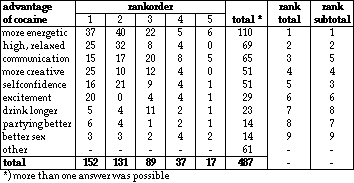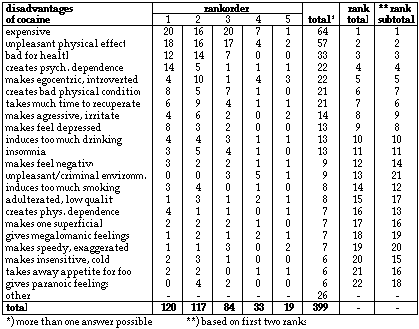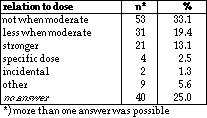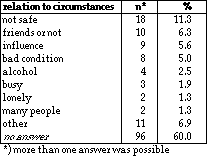Cohen, Peter (1989),
Cocaine use in Amsterdam in non-deviant subcultures. In: Peter Cohen (1990),
Drugs as a social construct. Dissertation. Amsterdam, Universiteit
van Amsterdam. pp. 124-131.
© Copyright 1990 Peter Cohen.
All rights reserved.
9. Advantages & disadvantages of cocaine
Peter Cohen
- 9.1 - Introduction
- 9.2 - Advantages of cocaine, as perceived by users
- 9.3 - Disadvantages of cocaine as perceived by users
- 9.4 - Relation between dose, circumstances and (dis)advantagese
- 9.5 - Comparisons with Miami and Toronto
Table of contents
9.1 Introduction
The following chapter will deal with the advantages and disadvantages of cocaine, as perceived by the respondents in this survey. In open-ended questions we asked respondents to mention advantages and disadvantages up to a maximum of five each. Both advantages and disadvantages were then ordered by the respondent in rank order of importance. This allowed us to analyse not only which advantages and disadvantages were mentioned most frequently, but also if agreement existed as to their relative importance. Respondents were completely free to choose their own words.
Respondents were also asked if either dose, or circumstances of use, or both, influenced stated advantages and disadvantages of cocaine as mentioned by them. If so, they were invited to explain this.
9.2 Advantages of cocaine, as perceived by users
The advantages of cocaine were categorized as follows: cocaine gives excitement [excitement], makes partying better, more festive, easier [partying better], gives feelings of being high, relaxed, beautiful [high, relaxed], gives self confidence [self confidence], makes one clear-headed, more concentrated on tasks, more creative [more creative], it is possible to go on drinking longer [drink longer], improves quality of love making [better sex], eases communication, relations, lessens shyness [communication], gives energy, one needs less sleep, less easily tired [more energetic]. A small residual category remained with other advantages [other].
Table 9.2.a shows the total number of times each of these advantages was mentioned, and also how often each advantage was given rank one, rank two, etc. through rank five. Respondents gave an average of 2.9 advantages. 'More energetic' was the most often mentioned (110 times) followed, at quite a distance, by 'high, relaxed' (69 times).
Table 9.2.a Number of times each advantage of cocaine is mentioned, and rank order given (N=159)

We looked into two ways of establishing a hierarchy of advantages of cocaine. One based on the total number a certain advantage is mentioned (in Table 9.2.a under 'rank total'), the other on the total number an advantage receives rank one or two ('rank subtotal').
The two advantages that rank one and two in the top nine, based on the total number of their being mentioned, keep their top ranks when we look at the number of times they are perceived as one or two, relative to other advantages mentioned by the same respondent. There can be no doubt that 'more energetic' and 'high, relaxed' are the most important advantages of cocaine as perceived in this sample. Some other perceived advantages change their ranks, depending on which way we compute them. The advantage 'eases communication', third in rank when we look at total times mentioned, drops to rank number five if we only consider its frequency of being mentioned as number one and two. Its place as number three is then taken by 'more self confidence'.
It could easily be reasoned that 'eases communication' and 'more self confident' are highly related or interchangeable for many respondents, making the observed changes in rank order on the hierarchy unimportant.
The first three advantages are quite instrumental in an outgoing lifestyle among peers. Advantage number four 'more creative', relates to more individual values. Probably this advantage plays a role for a particular type of user for whom cocaine is more instrumental in intellectual or artistic activities, than in a socializing life style.
According to a sizeable minority (29%) dose has no influence on the occurrence of mentioned advantages. Another 68% felt dose does have influence on the occurrence of the advantages. Most often this was explained in terms of a minimum or optimum dose. Three said:
"I often use just a little bit, to gain in concentration and to take away feeling tired."
(resp. 1087)"I only perceive some effect if I take at least three lines."
(resp. 1099)"If I use a lot, it turns bad and I feel I can not control it any longer."
(resp. 2012)
Table 9.2.b Relation of dose and circumstances to advantages of cocaine use (N=159)

Explanations about the relation between dose and the occurrence of advantages of cocaine were given 25 times in terms of minimum dose, and 37 times in terms of optimum dose. A small number gave an explanation in terms of a repeating dose (9 times) or gave a more complex answer, in terms of a changing relation between dose and advantages.Two more said:
"If you want to go on working, one line is not enough. You have to take another one every hour or so."When asked if circumstances influence the perceived advantages of cocaine, 30% denied this and 68% agreed. Among those who stated circumstances had an influence on advantages, 67 respondents explained this in terms of the quality of social relations within a group ('cosy', 'safe'). 23 respondents experienced their advantages mostly at parties. 14 respondents explained this influence as resulting from themselves being in a relaxed or easy going situation. Only 6 respondents mentioned the presence of some task as a positive circumstance for the advantages of cocaine to appear. Typical answers would be, as four other respondents put it:
(resp. 1107)"If I feel tired and I snort a few lines, it could go completely wrong. One time just one line can give the desired effects, another time one line does not."
(resp. 1120)
"If I am with people I dislike, effects may turn negative."
(resp. 1004)"The mood of a party or a disco has a large influence on these advantages. The better the general atmosphere, the better the effects of coke."
(resp. 1007)"In a good atmosphere with friends the advantages are really strong. But e.g. in a bar with a bad atmosphere, the advantages do not even appear."
(resp. 2024)"Positive effects normally do not appear if the situation does not cooperate."
(resp. 2032)
9.3 Disadvantages of cocaine as perceived by users
In the same way as we asked about advantages of cocaine, we asked our respondents about disadvantages. As can be seen from table 9.3.a, many
Table 9.3.a Number of times each disadvantage of cocaine is mentioned, and rank order given (N=160)

disadvantages were mentioned with a sum total of 399. This means each respondent perceives about 2.5 disadvantages, versus 2.9 advantages. Numerically seen there is a very slight imbalance in the direction of advantages, but of course this explains nothing about the weight of each advantage and disadvantage within the personal weighing systems of each respondent. For about one third of the sample the scale may have dropped on the side of the disadvantages, because they had stopped using cocaine.
In Table 9.3.a. we see the number of times a particular disadvantage was mentioned by the total sample, and how often an advantage received ranking one, two, etc through five. Of course, the top disadvantage (cocaine being expensive) may only be an artefact of the present legal situation and not a characteristic of the drug. For the rest of the analysis we will discard this disadvantage.
Because so many different disadvantages were mentioned, we have reduced the list to three categories: disadvantages relating to physical effects, disadvantages relating to psychological effects, and a residual category, other. Perceived physical disadvantages (unpleasant physical effects, bad for health, creates bad physical condition and creates physical dependence) are mentioned 118 times. Three of these four are in the top ten.
Disadvantages that relate to psychological effects are mentioned 115 times (creates psychological dependence, makes one egocentric, makes one aggressive, makes one feel depressed, makes one feel negative, makes one speedy, gives megalomaniac feelings, makes one superficial, makes insensitive and gives paranoid feelings). Four of these 10 are in the top ten.
Table 9.3.b Relation of dose and circumstances to disadvantages (N=160)


Physical and psychological disadvantages together make up only 58% of the number of disadvantages mentioned. The disadvantages in the residual category (minus 'expensive') account for the rest. None of the disadvantages, neither grouped nor itemized, come out as clearly applicable to a large proportion of the users. The most often mentioned disadvantage (unpleasant physical effects) was mentioned by just over a third of the respondents.
When asked if dose plays a role in the occurrence of stated disadvantages, 81.9% of the respondents agreed. Typical answers to the question on the relation between dose and disadvantages were:
"The more I use, the longer I stay awake and the more my physical condition suffers."
(resp. 1058)"If I use a lot [of cocaine] these disadvantages occur. With incidental use they are negligible. "
(resp. 1111)"A big dose will create these disadvantages."
(resp. 1115)
Circumstances play a much smaller role in the occurrence of disadvantages than dose, with 55.6% denying the influence of circumstances. Here we were confronted with unclear or even contradictory explanations. Of the latter category it was said:
"At parties or in small groups the egocentric effects of coke emerge easier than in larger groups or in big clubs."
(resp. 1058)"This egocentrism occurs only if you have very many people around you. With friends around it does not appear."
(resp. 1107)
9.4 Relation between dose, circumstances and (dis)advantages
Table 9.4.a shows the proportions of respondents who affirm a relation between: a) dose, and occurrence of disadvantages; b) dose, and occurrence of advantages; c) circumstances of use, and the occurrence of disadvantages; and d) circumstances of use, and the occurrence of advantages.
Advantages and disadvantages are both perceived as related to dose, but for the disadvantages the relationship is more marked. Moreover, for disadvantages, circumstances are considerably less important than dose. Table 9.4.a also shows that for advantages, both dose and circumstances play a more or less equal role. For the occurrence of disadvantages dose clearly is the most important factor. This analysis parallels our findings elsewhere. In chapter 10 we show that the probability of the occurrence of quite a number of adverse effects is related to dose/frequency of use. This is not an artefact of the relative ease of measuring dose compared to the near impossibility of measuring 'circumstances', because the same relation is found in two completely independent ways.
There is much more differentiation and much less agreement for disadvantages than is true for advantages. It is very difficult to decide if this is accounted for by the primary pharmacological effects of the drug or by the social characteristics of this group of non-deviant users. For instance, users surveyed here may have developed more agreement among each other about advantages than about disadvantages. One reason for this might be that in the lifestyles of these outgoing people discussion of negative experiences is not fashionable.
Table 9.4.a Proportions of respondents who affirm a relation between dosage and or circumstances with advantages and/or disadvantages, in percentages

But, as will be shown in chapter 10, we could search for completely different lines of reasoning. It might be that several clusters of different effects play a role. Users might be one of several types, distinguished by clusters of effects that apply to each type. If this hypothesis proves true, we would have to stop discussing 'the' effects of cocaine or 'the' advantages versus disadvantages, because we would have to consider instead different types of users, possibly subdivided again by level of use and circumstances of use. For a rational discussion of disadvantages or adverse effects of cocaine this distinction of different types of user seems a plausible line of reasoning[1]. However, this does not explain why agreement on the positive effects of cocaine is so much larger than agreement on negative effects. If effects of cocaine are different for different types of users, one might expect this to be valid for equivalently both positive and negative effects.
9.5 Comparisons with Miami and Toronto
Unfortunately no comparison is possible with the two other studies that used community-based samples. In these studies, a dissimilar approach to collecting knowledge about perceived positive and negative effects was adopted. Only the Toronto study reports some findings on 'most' and 'least' appealing aspects of cocaine in respondents own words and then grouped under broader headings. Two characteristics of cocaine reported by Toronto respondents can be compared with Amsterdam respondents' perceptions. It seems that in Toronto 'energy' (either mental or physical) is mentioned by many respondents (32%) as the most appealing aspect of cocaine. In the Amsterdam sample, only 23% gave 'energy' this status. In Toronto, 7% of respondents reported (increased) confidence as the most appealing aspect. In Amsterdam, 10% of our respondents rated this advantage as number one. But this kind of comparison is still rather suspect, until more standardized methods of measuring effects are adopted by researchers cross-culturally.
For reasons of comparibility we also used lists of standard effect items, identical to those used by Morningstar and Chitwood (1983) and Spotts and Shontz (1980). To these we will turn in the next chapter.
